
table of contents
- Outdoor cacti
- Hardy cactus varieties
- Cylindropuntia
- Echinocereus (hedgehog column cactus)
- Escobaria
- Opuntia (Opuntia)
- Pediocactus simpsonii
- Maihuenia
- conditionally hardy cactus varieties
- Coryphantha
- Gymnocalycum andreae (hump cactus)
- Grusonia clavata
- Lobivia famatimensis
- Mammillaria
- Dormant period
- wintering
- Hibernate cacti in the bucket
- Hibernate cacti in the bed
- Substrate
Creating a bed or even a cactus garden with colorful, blooming cacti in our latitudes does not have to remain a dream. There are actually some hardy species that provide exceptional accents in the garden all year round. Choosing the right variety is important so that you can enjoy the thorny beauties in the tub or bed for a long time. We have therefore put together a list of types and types of cacti that are particularly suitable for this.
Outdoor cacti
Among the many different species of cacti, there are a number of candidates that have good winter hardiness. In nature, these cacti mostly come from the mountainous regions of Central and North America, where they are used to very low temperatures. In our latitudes, however, they have the problem that in the winter months it is not only cold, but also damp or even wet. For this reason, hardy cacti that have a place in the bed or in a tub on the balcony must be protected from excessive moisture.
Hardy cactus varieties
If they are protected from excessive moisture, they can withstand temperatures as low as -25 ° C without any problems. In slightly more humid locations, which must never be wet, they can still tolerate -15 ° C to -20 ° C. The following types and varieties of cacti have proven to be particularly hardy.
Cylindropuntia
These succulent beauties reach heights of up to one meter with their long, cylindrical shoots. The Cylindropuntia does not bloom for around five to ten years, but is then very blooming. In the year after flowering, yellowish fruits ripen on the plant. A special feature of these cacti are the beautiful fresh shoots that take on a pink-pink hue. In winter, the plants let the finger-shaped shoots hang down a little in the upper area. From April these shoots pull themselves up again on their own.
- only blooms from the age of 5 to 10 years
- Growth rate: 2 to 10 cm per year
- Without rain protection: about -15 to -20 ° C hardy
- Winter hardy to -25 ° C with rain protection

Hardy varieties of Cylindropuntia:
Cylindropuntia imbricata
- 'Pinky': strong pink-colored flower bases, later colored slightly wine-red
- 'Marco': salmon-red new shoots, up to 2 m height, pink flowers
- 'Walter': old pink flowers
- 'Uhlig': bright pink flowers
- 'Stürzer': pink flowers
Cylindropuntia whipplei
- 'Würzburg': yellow flowers
- 'Fredonia': sun-yellow flowers
Cylindropuntia viridiflora
- 'Frank': salmon-colored flowers with yellow stamens
- 'Cylindropuntia x spinosior'
Echinocereus (hedgehog column cactus)
If you offer Echinocereus protection in winter, this cactus can withstand temperatures as low as -15 ° C. The plants grow as small, columnar cushions and are very willing to flower even as very small plants. Their elongated, round shoots form small clumps with hair, some like cotton wool, between the thorns. After around ten years, these cushions reach a diameter of around 20 cm. The fruits of the Echinocereus are dry and do not form pulp. These cacti come mainly from the arid regions of the southern USA and Mexico.
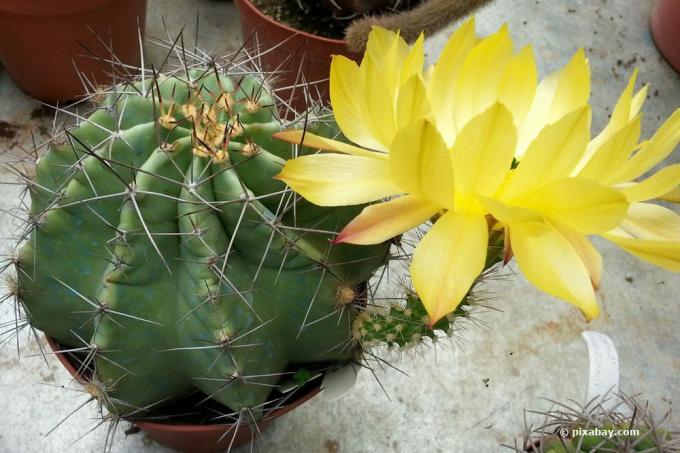
Varieties of Echinocereus cacti:
- Echinocereus chisoensis: deep pink flowers with a brown throat and creamy white stamens
- Echinocereusreichenbachii ssp. baileyi: pink flowers with a brown base and yellow stamens
- Echinocereus russanthus 'Brewster Co Tx': yellow flowers
- Echinocereus dasyacanthus: yellow flower, occasionally orange, pink or purple in color
- Echinocereus caespitosus: pink flowers
- Echinocereus perbellus: strong pink-pink flowers
- Echinocereus triglochidiatus: bright orange-red or deep red flowers
- Echinocereus viridiflorus: wide open, green-yellow flower
- Echinocereus chloranthus var. cylindricus: brownish-yellow flowers
Escobaria
The Escobaria cacti usually form larger, spherical plants with felty creamy-white thorns. With age, these cactus varieties grow increasingly as dense clumps up to 20 cm in diameter. After flowering, small red or green fruits about one centimeter in size ripen in October to November. These fruits have no thorns and are edible. The taste is a bit reminiscent of a gooseberry. When cultivating Escobaria, it is important that it is not watered too much in the bucket or bed in summer. Otherwise, it tends to be lazy.
- Winter hardy to -25 ° C with rain protection
- Flower colors: available in different colors and color combinations
Varieties of the Escobaria cacti:
- Escobaria vivipara
- Escobaria neomexicana
- Escobaria arizonica
- Escobaria sneedii
- Escobaria sandbergi
- Escobaria organensis
- Escobaria asperispina
- Escobaria missouriensis
Opuntia (Opuntia)
The opuntia is one of the most beautiful and popular hardy cactus species. It forms medium-sized, disc-shaped shoots that branch out strongly, especially in the area close to the ground. In total, these cacti are only about 40 cm high and form long, white thorns. The succulent plant is very frost-resistant, especially in the tub on a covered balcony. In contrast to many other hardy cactus varieties, the Opuntia forms a large number of flowers after one to two years, which when fertilized insects later ripen into dry fruits. The different varieties of Opuntia polyacantha and Opuntia macrocentra var are particularly frost-resistant. nevadensis, the latter showing a beautiful winter color. The Opuntia is ideal for planting in a rain-protected bed and an absolute must for cactus lovers.
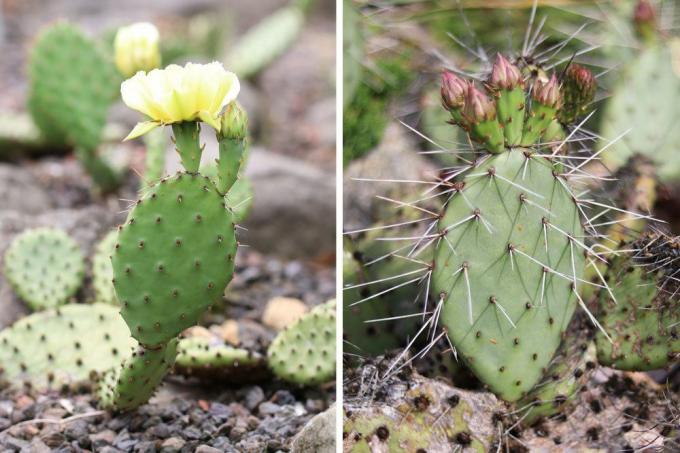
Hardy varieties of Opuntia polycantha:
- 'Christel Tide' / 'Richter': white flowers with a pink throat
- 'Snowball': white flower with a light yellow background
- 'Apricot': strong apricot colored flowers
- 'Linz': red flowers
- 'Kaiserstuhl': red flower
- 'Orangade': strong red-orange flowers
- Opuntia polycantha finermis: produces edible fruits
Other opuntia that turn out to be particularly hardy:
- Opuntia basilaris var. humistata
- Opuntia aurea
- Opuntia rutila
- Opuntia phaeacantha
- Opuntia scheeri: greyish green shoots
Pediocactus simpsonii
This species of cactus inhabits the western United States from New Mexico to southern Canada. Almost all plants grow there at an altitude between 2000 and 2800 meters as a solitary plant with a diameter of around eight centimeters. In contrast to most other types of cacti, Pediocactus simpsonii flowers very early in the year. From mid-April pink or yellowish flowers appear. Individual variations of this type of cactus are among the hardest hardy species among the cacti and are therefore likely to grow even in higher alpine locations. However, the plants are somewhat sensitive to moisture.

Maihuenia
This small species of cactus from Argentina develops green, petal-round leaves with short, very strong thorns. The blue-green shoots are around six centimeters long and quickly form large mats in the bed. Although well hardy, the Maihuenia also has a small disadvantage: It is particularly lazy to flower, especially in the first few years.

Varieties of Maihuenia cacti:
- Maihuenia poeppigii
- Mahuenia patagonica
- Mahuenia valentinii
conditionally hardy cactus varieties
The following cacti are somewhat more sensitive to permanent frosts or extreme cold spells. Nevertheless, in most locations they are quite suitable for planting in pots or beds and can be left in a protected place in the open all year round.
Coryphantha
This type of cactus originally comes from North America and usually forms larger, but flat, spherical cushions with very long, gray thorns and beautiful, purple flowers. With rain protection, the cacti are frost-resistant down to temperatures between -12 ° C and -18 ° C.
Types of Coryphantha cacti:
- Coryphantha echinus
- Coryphantha macromeris
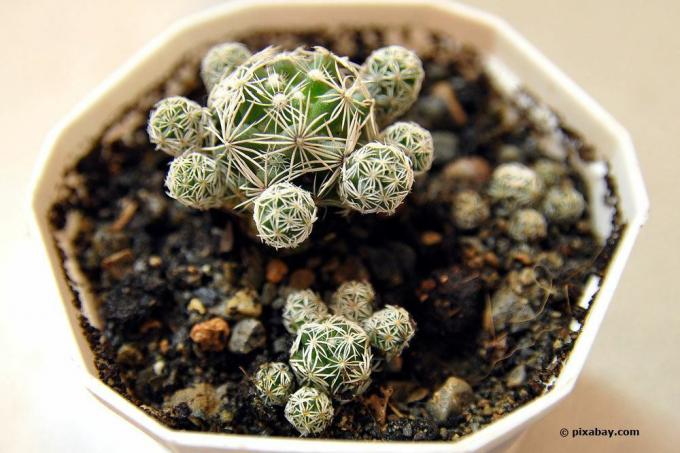
Gymnocalycum andreae (hump cactus)
With a growth height of only 10 to 20 centimeters, the hump cactus is one of the smaller cactus varieties that are well hardy. With around 50 species, Gymnocalycum occurs almost exclusively in desert regions. The bright green colored plants are spherical in shape and have hump-like ribs. Often they are cultivated for the interesting thorns. The cacti come into their own best when you plant them in smaller groups in the bed.
- Winter hardiness with rain protection: -12 ° C to -17 ° C
- reacts a bit sensitive to permanent frost

Grusonia clavata
The Grusonia clavata grows only very weakly and forms small, club-shaped shoots that are covered with long, mostly light-colored thorns. Larger specimens occasionally bloom, usually in shades of yellow. The succulent plants are less sensitive to the cold than to moisture, especially in the cooler months.
- Winter hardiness without rain protection: -12 ° C to -18 ° C
- Winter hardy to -25 ° C with rain protection
Lobivia famatimensis
The species, also known as Reicheocactus, comes from South America (Argentina) and grows dwarfish with noticeably thickly covered flowers. Usually the plant can be found individually, only occasionally does it form larger cushions. What is striking about the spherical to cylindrical cacti is the sunken shoot apex. The funnel-shaped flowers of the Lobivia are usually yellow to orange-yellow in color. In our latitudes, the plants are hardy to around -15 ° C and can therefore be easily planted in a tub on the balcony.
Mammillaria
With around 400 species, the genus Mammillaria is one of the largest cactus families. But most of the species are not sufficiently hardy with us. These extraordinary, North American cacti grow as a round disc to a flat ball with beige-colored, strong thorns. After flowering, beautiful, elongated red fruits develop on the plant. The Mammillaria likes to form groups. So-called kindels arise at the base of each plant. In contrast to many other types of cactus, the surface of the round body is not covered with ribs, but contains spirally arranged warts from which the thorns arise.
- Winter hardiness with rain protection: -12 ° C to -18 ° C
- Hardly hardy without rain protection
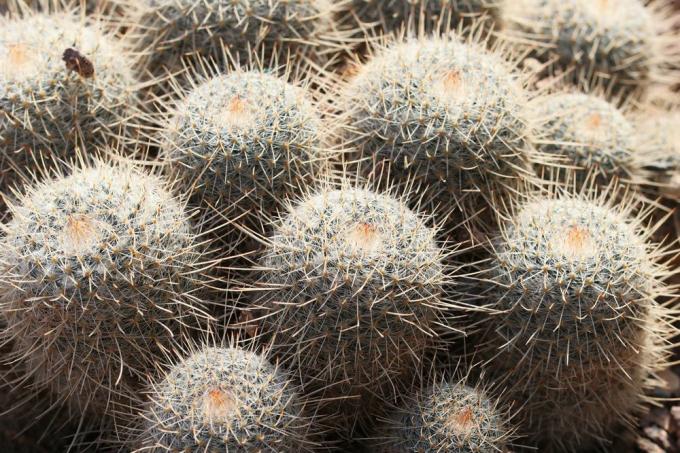
other Mammillaria varieties:
- Mammillaria meiacantha
- Mammillaria haudeana
- Mammillaria heyderi
Dormant period
From autumn the metabolism of the succulent plants slows down and the cacti enter a resting phase. In winter they almost completely stop growing and put all their energy into the formation of the flowers in the following year. As a rule, the plants then change their appearance and become limp and wrinkled. If the cactus leans towards the ground, this is not a cause for concern, it is completely normal. This is the only way to survive the icy temperatures. In the next spring, when fresh juices get into the shoots again, the hanging parts of the plant stand up again by themselves.
wintering
Hibernate cacti in the bucket
Even if the cacti, which are in a smaller bucket or pot on the terrace, the balcony or in the Stand in the garden, are hardy, it suits them best if they are brought into the house before winter will. The roots of the plants are less well protected in a planter than those of specimens that are planted in the bed. Therefore, they cool down faster and may be damaged. You should consider the following when wintering your cacti in the bucket:
- before the first severe frosts
- best of all right away Pests or control diseases
- never overwinter in the warm apartment
- Temperature: 4 ° C to a maximum of 12 ° C
- bright but without direct sunlight
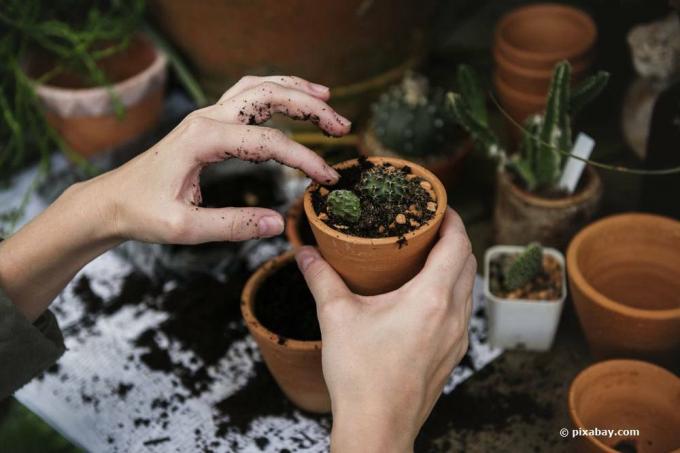
If the hardy cacti are already very large and can no longer be given away so easily, if they should hibernate outside, they must be protected from rain and cold winds will. In order to optimally protect the roots, the planter should have a volume of at least four liters. Smaller pots are better off in a cold house.
- Place in a protected place on the house wall
- protected from rain under a canopy
- sunny to partially shaded
- Place the pot on a thick styrofoam plate (at least 5 cm thick)
- Wrap the bucket with fleece or air foil
- Do not cover plants themselves
Hibernate cacti in the bed
Many of the cactus varieties mentioned are hardy with rain protection down to -25 ° C. They can easily be planted in a protected bed and left outdoors all year round. For planted cacti that are sufficiently hardy, southern slopes or hill beds are particularly suitable. You may not under any circumstances such as Palm trees be covered to protect against the cold, as they need a lot of light even in the cold season. A snow cover is not a problem for the succulent plants. On the contrary, the snow layer protects the plant and the soil from cooling down. When wintering cacti in the bed, the following applies:
- hibernate partially hardy cactus species in unheated polytunnels
- Leave the doors open on both sides
- mainly serves to protect against moisture
- Water carefully again from the end of February
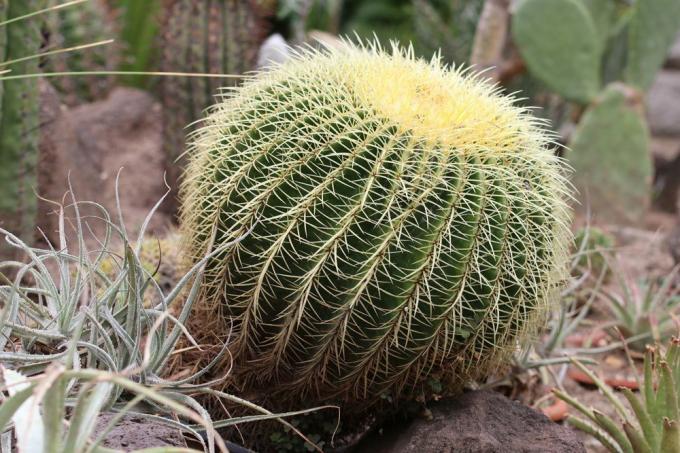
Substrate
The substrate is an important factor for a good wintering of the cacti outdoors. It basically has to be extremely sandy and crumbly. This ensures good water permeability and the roots can easily spread into deep layers of the earth.
- Rock granulate
- Pumice
- sand
- fine gravel
- Loess earth (for example from a field or from a construction pit)
- the earth share may not exceed 15%



